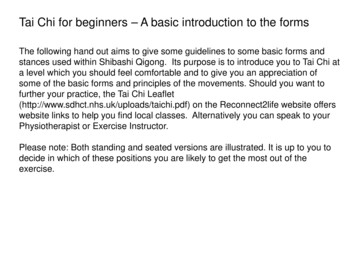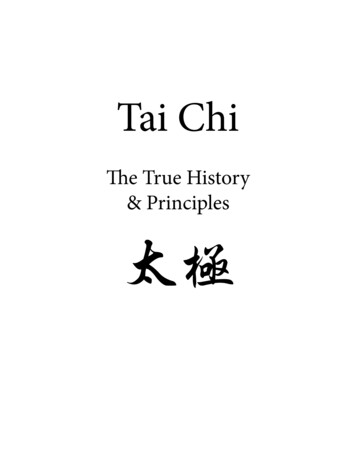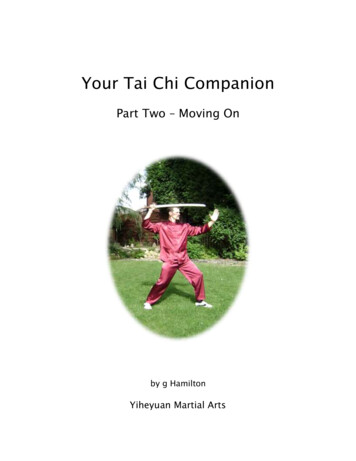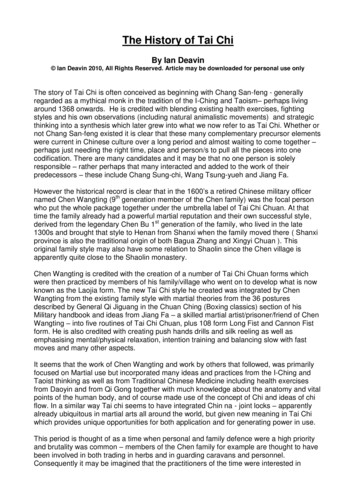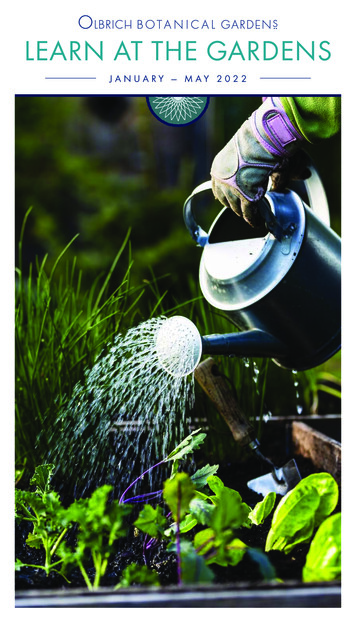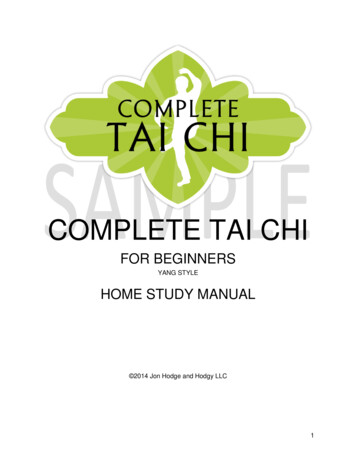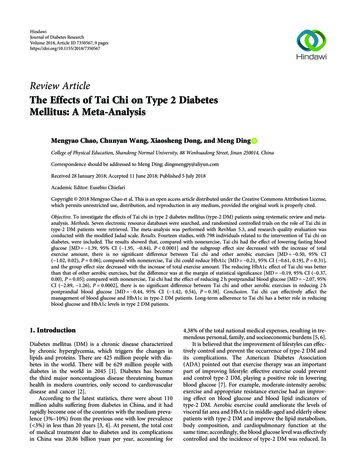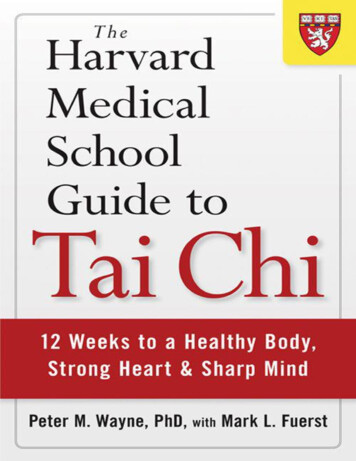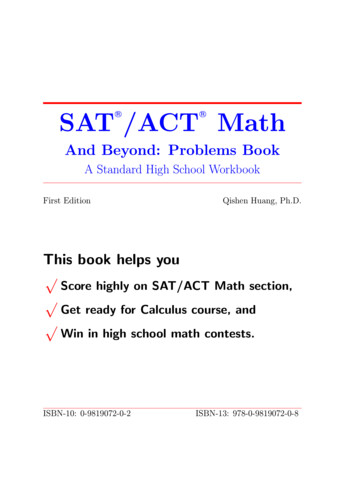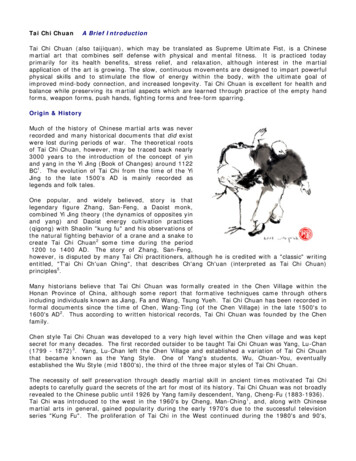
Transcription
Tai Chi ChuanA Brief IntroductionTai Chi Chuan (also taijiquan), which may be translated as Supreme Ultimate Fist, is a Chinesemartial art that combines self defense with physical and mental fitness. It is practiced todayprimarily for its health benefits, stress relief, and relaxation, although interest in the martialapplication of the art is growing. The slow, continuous movements are designed to impart powerfulphysical skills and to stimulate the flow of energy within the body, with the ultimate goal ofimproved mind-body connection, and increased longevity. Tai Chi Chuan is excellent for health andbalance while preserving its martial aspects which are learned through practice of the empty handforms, weapon forms, push hands, fighting forms and free-form sparring.Origin & HistoryMuch of the history of Chinese martial arts was neverrecorded and many historical documents that did existwere lost during periods of war. The theoretical rootsof Tai Chi Chuan, however, may be traced back nearly3000 years to the introduction of the concept of yinand yang in the Yi Jing (Book of Changes) around 1122BC1. The evolution of Tai Chi from the time of the YiJing to the late 1500's AD is mainly recorded aslegends and folk tales.One popular, and widely believed, story is thatlegendary figure Zhang, San-Feng, a Daoist monk,combined Yi Jing theory (the dynamics of opposites yinand yang) and Daoist energy cultivation practices(qigong) with Shaolin "kung fu" and his observations ofthe natural fighting behavior of a crane and a snake tocreate Tai Chi Chuan2 some time during the period1200 to 1400 AD. The story of Zhang, San-Feng,however, is disputed by many Tai Chi practitioners, although he is credited with a "classic" writingentitled, "T'ai Chi Ch'uan Ching", that describes Ch'ang Ch'uan (interpreted as Tai Chi Chuan)principles5.Many historians believe that Tai Chi Chuan was formally created in the Chen Village within theHonan Province of China, although some report that formative techniques came through othersincluding individuals known as Jiang, Fa and Wang, Tsung Yueh. Tai Chi Chuan has been recorded informal documents since the time of Chen, Wang-Ting (of the Chen Village) in the late 1500's to1600's AD2. Thus according to written historical records, Tai Chi Chuan was founded by the Chenfamily.Chen style Tai Chi Chuan was developed to a very high level within the Chen village and was keptsecret for many decades. The first recorded outsider to be taught Tai Chi Chuan was Yang, Lu-Chan(1799 - 1872)3. Yang, Lu-Chan left the Chen Village and established a variation of Tai Chi Chuanthat became known as the Yang Style. One of Yang's students, Wu, Chuan-You, eventuallyestablished the Wu Style (mid 1800's), the third of the three major styles of Tai Chi Chuan.The necessity of self preservation through deadly martial skill in ancient times motivated Tai Chiadepts to carefully guard the secrets of the art for most of its history. Tai Chi Chuan was not broadlyrevealed to the Chinese public until 1926 by Yang family descendent, Yang, Cheng-Fu (1883-1936).Tai Chi was introduced to the west in the 1960's by Cheng, Man-Ching1, and, along with Chinesemartial arts in general, gained popularity during the early 1970's due to the successful televisionseries "Kung Fu". The proliferation of Tai Chi in the West continued during the 1980's and 90's,
particularly due to the recognition of the health benefits of the art. Tai Chi Chuan is now the mostwidely practiced martial art in the world3.Summary of Major Tai Chi Chuan StylesMany Tai Chi styles and variations of styles have been passed down through the generations. Threestyles of Tai Chi Chuan are considered to be the "major" systemstaught throughout the world, although there are many modifiedversions. These styles, Chen, Yang, and Wu, are named after thefamilies that founded them (see Origin & History). Each of thesestyles, or systems, has characteristics that make it distinct from theothers, however most of the general principles of Tai Chi Chuan are thesame for all of them (principles of body structure, mind-bodyintegration, relaxation and breathing, and others, see (Introduction toTai Chi Chan Principles).The primary differences between the three major styles are: 1) Chencontains hard as well as soft techniques, some resembling regular kungfu with fast, hard power and footwork; 2) Yang is made up of large,graceful circles, and the techniques are easy to see and understand; 3)Wu uses smaller circles with more throwing and pushing techniques4.There is another, less practiced, style known as Sun style Tai Chi (also derived from the "majors"),founded by Sun, Lu-Tang that deserves mention. Sun combined many techniques of the otherChinese "internal" martial styles Hsing-I Chuan and Bagua Chang into his Tai Chi Chuan style3.Choosing a SchoolTai Chi Chuan is taught as a series of movements, or forms, that comprise a set. The set mayinclude a small number of forms, say 13, or a much larger number of forms, say 108, dependingupon the style, school, and suitability to the practitioner. The martial aspects of Tai Chi Chuan arelearned through practice of the form sets, push hands (a training technique with a partner todevelop sensitivity to body momentum), and fighting sets at advanced levels. When selecting astyle and school, beginning practitioners should asses their interests and choose accordingly. Apartial list of considerations is as follows:Does the style suit my physical condition and developmental interests?Does the school teach a comprehensive Tai Chi Chuan system (training for health, self-cultivation,and self-defense)?Does the school have a program for seniors?Does the school emphasize spiritual growth and meditation only (suited to individual interests)?Does the teacher have the appropriate understanding of the art to meet my training needs?The better the match of style and school to the interests of the student, themore likely the student will continue training. In most cases, prospectivestudents are permitted and encouraged to visit a class and ask questions prior tomaking a commitment to join a school. It is recommended that prospectivestudents do some research prior to reviewing schools in order to improve theirselection.Research and supplemental training are also recommended through books,videos/DVDs and the internet. Such research, in addition to enhancing the
learning process, will continue to stimulate the interest of the practitioner and improve the odds ofstaying with training. Success in learning Tai Chi Chuan only comes through perseverance anddetermination over time.Introduction To Tai Chi Chuan PrinciplesThis introduction to Tai Chi Chuan principles is intended to be very basic and easy to understand for beginning practitioners.There are many styles and versions of styles of Tai Chi being taught throughout the world. Thereare, however, several basic principles that are fundamental to all Tai Chi systems. When learnedand trained, these fundamental skills form the basis of a practitioner's pursuit of Tai Chi's healthbenefits, martial power, and self-knowledge. Although simple in concept, the embodiment of theseprinciples and the realization of what they can ultimately manifest in the human mind and body maytake a lifetime.It should be emphasized from the beginning that Tai Chi Chuan is a Mind-Body endeavor. Morethan an exercise system for the physical development of the body, one of the fundamentals of theart is that the mind (the attention and the intention) focus and unify the body in stillness,movement, and purpose. This principle increases in importance, and significance, as the practitionerprogresses through training.Some general principles are summarized as follows:Tai Chi is based on the principle of softness defeating hardness. Muscular power is de-emphasizedand the intrinsic strength of the bones, tendons, ligaments and musculature are developedthrough relaxation and proper structure. The goal is to remove all tension from the muscles andjoints, using just enough muscular strength to execute the forms and maintain a spiritedreadiness. The key principle here is to relax. Martial effectiveness comes not through bruteforce, but through the skillful execution of technique. Incoming force is avoided, dissolved,deflected, and redirected.Beginning students often wonder how "yin" and "yang" apply to Tai Chi Chuan. Yin and Yang arebasically opposites - opposites or contrasts of anything and everything, including emptiness andfullness. In Tai Chi, early training emphasizes distinguishing emptiness from fullness instepping. As forms are executed, the practitioner maintains 100 percent of the body weight onone leg (fullness) or the other with brief, interim periods of "double weightedness" while intransition from step to step (double weightedness results in diminished agility). The non-weightedleg is said to be empty. Steps are taken forward by moving all weight to the supporting leg andextending the stepping foot, touching heel first before moving any weight onto that leg.Movement to the side or rear reaches and touches with the ball of the foot prior to weighttransfer. The words "fullness" and "emptiness" are commonly equated to "substantial" and"insubstantial", respectively - semantics vary from school to school. The body quality in thistechnique is often compared with the movement of a cat. This stepping technique is usuallydifficult for the beginner as leg strength and balance must develop to accommodate the load.Along with deep relaxation and correct stepping, the body must be allowed to"sink". Relaxing and sinking are a skill that must be developed in order to"root". A primary source of stability and power in Tai Chi Chuan is properrooting. In short, this amounts to lowering the center of gravity of the body,thus improving balance and stability. Visualizations are of key importance insinking/rooting - this requires using the imagination, attention and intention tosee the body sinking and rooting deeply into the earth and allowing the body tophysically adjust to the mental visualization. A primary goal is to sink,establish a root and maintain the rooted body quality during all Tai Chitechniques.Part of the "magic" of Tai Chi Chuan is apparent effortlessness producing incredible power. A keyprinciple (in combination with all the others) that makes this possible is that of correct bodystructure. Correct structure is achieved by straightening the spine, relaxing all the joints
(especially elbows, shoulders, hips and knees), and lowering the center of gravity (sinking). Theknees are bent, and the shoulders are sunk and adjusted forward to slightly concave the chest.The forward knee should not bend to the point where it extends beyond the toes. It should beemphasized that proper joint alignment should always be maintained to prevent injury (keep theknees aligned with the toes). The scapulae should be rounded and the elbows should be down.The body should feel as though the crown of the head is being suspended by a thread fromabove. The rest of the skeletal structure may be visualized as "hanging" from the suspendedcrown of the head. The coccyx, or tail-bone, is tucked under the body and the lumbar region ofthe spine straightens as a result. The combination of suspended head and tucked tail-bonestraightens and elongates the spine. The spine angle is then maintained upright or slightlyforward, depending upon the style and philosophy of the school. The structurally correct androoted body, when properly integrated, is capable of amazing balance and power. The process oflearning these skills improves physical health, strength, and mental focus.Tai Chi movement is smooth and continuous, and is directed by the legs, waist and spine.Movements are circular, the waist is rotated around the axis of the spine, and the center ofgravity is maintained near a constant height above the ground (except for specific forms thatrequire adjustments of height). The body's center of gravity is often referred to as the dantian,or tan t'ien, and is located approximate 2 to 3 inches below the navel and centered within thebody. Tai Chi movements are integrated - the body moves as a unified entity. The extremities donot move independently of the body.All of the previously mentioned principles and skills require focus and the maintenance of themind's attention in the "present moment". This is to say the mind is cleared of extraneousthoughts (a condition referred to as wuchi, or no extremity), and the attention is on what you aredoing. The intent is directed to the purpose of what you are doing, which requires anunderstanding of the martial applications of the Tai Chi forms. If you understand what theforms were designed to do, you will be able to apply your intent (what you are intending to dowith the form, for example deflecting an incoming punch) and further the development of yourmind/body integration.Many beginning practitioners hear about Chi, or Qi, and wonder what it is andwhat it's about. At present, there is no definitive scientific process or study thatcan identify, quantify, or specifically describe Chi. Some believe that Chi isbioelectric energy moving through the acupuncture meridians throughout thebody. Others believe it is the primordial life force or energy with which we areborn. Many practitioners equate Chi with blood flow and breathing. From anexperiential standpoint, Chi is a sensation that may be experienced, trained andutilized to improve the effectiveness of martial arts, and the health of the body(it is well documented that positive attitude and visualization may improvehealth). The sensation of Chi may be cultivated through deep relaxation and theopening (relaxation) of the body's joints. This amounts to a heightenedawareness of the body and a heightened sensitivity to the movementand intention of others in proximity to the body. Maintaining the sensation ofChi flowing through the body helps to maintain the correct body quality of relaxation duringexecution of Tai Chi Chuan techniques.Another key Tai Chi principle is that of correct breathing. Breathing should be slow, gentle anddeep (meaning deep into the lungs utilizing the diaphragm versus shallow breathing in the upperlungs) through the nose. The tongue should be lightly pressed against the roof of the mouthbehind the front teeth and the mouth should be lightly closed. Breathing should be coordinatedwith the form movements - generally breathing in when rising or moving back, and breathingout when sinking or moving forward (especially when striking). The breath will typically becomenaturally synchronized with movement as the practitioner's skills and stamina improve. Correctbreathing will generally increase blood flow, and improve the capacity of the lungs.The eyes should be relaxed (relaxed eyes help relax the rest of the body) and assume a "lazy"gaze generally forward in the direction of the torso (some forms will have specific techniques forthe gaze). Relaxed eyes also improve peripheral vision, thus detection of movement in thevicinity.The practice of Tai Chi Chuan is a pursuit of self-knowledge and self-mastery. In addition to the
many physical health benefits of the practice, the opportunity for life-changing personal growth,stress relief, and spiritual growth is profound.The Tai Chi SymbolThe Tai Chi Symbol (also twin fish symbol and yin - yang symbol) is familiar to almost everyone,although most don't know what it is or represents. The white portion of the symbol represents yinby virtue of it's lack of color. The black portion represents yang. In general, yin and yang areconsidered opposites of virtually anything, and the shape of each side of the symboland it's rotational character represent the relative proportions of yin to yang as theycontinuously change and cycle from one to the other and back (essentially the natureof all things). The small circular areas of white within black and black within whiteindicate that, even in the extreme, there is always a little yin within yang and a littleyang within yin. Examples of yin may include; dark, soft, night, cold, empty, etc.Examples of yang relative to these yin examples may include; light, hard, day, hot, full, etc.,respectively.The most basic significance of this to the practitioner is the diagram's representation of the qualitiesof Tai Chi movement and energy - namely that one must distinguish fullness from emptiness, orsubstantial versus insubstantial in movement. The diagram shows the relationship of one to theother through the entire spectrum between the two opposing extremes. The discussion of correctTai Chi stepping in the Principles section above is a good example. The full and detailed analysis ofthe symbol and the depth of it's significance is a study of its own, and will be left to those interestedin further understanding.Beyond the Solo Form SetsLearning and practicing the solo form sets provides a wonderful exercise, and may fulfill the trainingneeds of many practitioners, particularly seniors interested in improving balance, mental focus andhealth. For those with a deeper interest in Tai Chi Chuan, there is a vast range of techniques, skills,and applications to be learned.Some of the areas of study beyond the solo forms may be summarized as follows:Martial Applications of Each Form - Each of the Tai Chi movements, or forms, has anapplication to self defense. Even many transitional movements that may seem insignificant servesome defense or attack purpose. Tai Chi, in fact, is recognized within the martial community asone of the most powerful and effective martial arts ever developed. The true heart of Tai ChiChuan is within the applications; after all, Tai Chi Chuan is first and fore-most a martial art.Push Hands - Push hands is a training technique practiced with a partner.There are several styles of push hands (each Tai Chi style has its ownvariations), including various stances and means of contacting the partner.The basic goal is to train the body's balance and root and the ability toneutralize force applied by the partner and to redirect that force to theground and back to the partner. It is also the basic training of sensitivity,both to the practitioner's own body and to that of the partner. The idea is tolearn to "listen" to the partner's force and momentum, and to then use that"understanding" to move the partner off balance. The technique is practicedslowly, using the least amount of muscular power possible to uproot thepartner. Deep relaxation and proper body structure are a necessity.Sticky Hands - Sticky hands is another training technique practiced with a partner. As with pushhands, there are several styles and various stances and means of contacting the partner. Thebody qualities of deep relaxation, body structure and rooting are also similar to push hands.Sticky hands training differs from push hands primarily in the intent of the practitioners. The ideais for the partners to help each other to learn to follow the movement of the other and "stick" to,
or maintain contact with, the partner. The technique is intended to train sensitivity to themomentum and intent of the partner. Typically, games are played by the practitioners where onepartner moves one or both arms and the other attempts to stick and follow the movement.Another game involves one partner "hiding a hand", or trying to free-up a hand from the partner'stouch in order to execute a strike. Slow-speed attempts to breach the partner's defenses enhancethe training. The premise here is that the sense of touch is near the speed of light versus therelative slow reaction time of vision. If contact can be made with an attacker, the trainedpractitioner should immediately "know" and "understand" the intent of the attacker and make apreemptive defensive or offensive movement. Push hands and sticky hands are very similar intechnique, body quality, and training objective - the development of martial skill.Weapon Sets - Tai Chi Chuan includes form sets executed with various weapons, includingsword, saber, staff, spear, and others. Form sets may be learned as solo forms or form sets witha partner.Fighting Sets - Martial skill is further developed by learning and practicing fighting form sets witha partner.Free-Form Sparring - As with other martial arts training, free-form sparring may be practicedunder controlled and supervised conditions. Tai Chi sparring is commonly done at slow speed, butwith power. The slow motion is necessary to avoid injury to the sparring partners - Tai Chi martialtechniques are notoriously dangerous and must be practiced with care.Qigong, or Chi Kung - Qigong is the practice of cultivating, moving, and applying body energy,or chi (see introduction to Chi in the Principles section). Technically, the practice of Tai Chi Chuanis also the practice of Qigong. A fundamental aspect of Tai Chi is developing the sensation of chiflow within the body. The sensation of chi flow helps the practitioner establish and maintain theproper body quality for executing Tai Chi techniques. The chi sensation my be manipulated by themind and directed by the practitioner's intent and purpose. An example is that when executing astriking or deflecting movement in the Tai Chi set, the practitioner creates the sensation that thechi is directed and emitted from the body (through the striking or deflecting hand/arm or foot/leg)in the direction of the strike or deflection to increase the power of the technique. This practice isone of many forms of qigong. Qigong practices include many styles of both stationary and movingtechniques. The common goal of these is to cultivate and circulate the chi sensation through thebody for improved mental and physical health, and to enhance the effectiveness of martialtechniques.Approaching MainstreamVirtually everyone has heard of Tai Chi and most have an opinion or perception of what it is about.A pervasive view among those not directly familiar with Tai Chi is that it is an extremely esoteric,even cult-like undertaking that is not well suited for the average American. Tai Chi has also beenbranded as a dance or meditative practice that includes light exercise, and is intended to bepracticed by the elderly.Although Tai Chi Chuan is the most practiced martial art in the world,the previously mentioned views have somewhat moderated its growthwithin mainstream America. There is some truth to thoseperspectives in that Tai Chi involves meditative aspects, is beautifulto watch when performed by an expert, has a mysterious history, andis well documented as an excellent form of exercise for the elderly.But the true depth of Tai Chi as a martial art and lifelong healthexercise that is capable of building tremendous strength of both body and character has still notbeen broadly revealed.The good news is that there seems to be movement toward mainstream acceptance of Tai Chi as acontemporary health and self-defense alternative. Medical general practitioners, orthopedicphysicians and physical therapists are recommending the practice of Tai Chi with more regularity.Tai Chi classes are showing up in more health clubs and residential development clubhouses. Therealization that, for some time, Tai Chi has been "gutted" of its martial heritage, and that there are
very few true adepts, has fueled a trend toward teaching martial applications and power aspects ofthe art, thus drawing interest from a more diverse group of new students.It's not clear that Tai Chi Chuan will attain the popularity of kick boxing or aerobics classes, but timeand correct information combined with practical communication could draw Tai Chi Chuan further outof the shadows.Practitioner's PerspectivesThere seems to be a good deal of debate in Tai Chi circles about what the art should be and towhom. One outlook is that Tai Chi Chuan is a multifaceted pursuit with many possible courses ofstudy and training. As diverse as people and their individual interests are, Tai Chi providesopportunity to match these interests, physical condition, and personal needs with a health-exerciseprogram or self-defense program. The trick here is to find the right school and teacher for theindividual.There are a few clear reasons that people take interest in Tai Chi. Some arestressed to their limit by the demands of daily life and seek an intellectualdistraction, or pursuit that focuses on relaxation and the centering of mind andbody. Others may be looking for an exercise program that will hold their interest forthe long term and not cause them injury. Still others wish to undertake martial artstraining for fitness, self-discipline, and self-defense - a martial art that they canpursue well into old age without loss of effectiveness. And others may be in theirsenior years, in search of activity, improved health and balance, and interaction witha group of people.The truth is that all of these reasons for taking interest in Tai Chi are valid and appropriate in-and-ofthemselves. Many practitioners, however, train to fulfill all of the objectives mentioned above, andseek the fullest possible understanding and experience that Tai Chi Chuan can offer. Whatever thepurpose or goals each individual has in taking up the practice of Tai Chi, all should be appreciatedfor their role in perpetuating the art.References1.2.3.4.5.Taijiquan - Classical Yang Style; Dr. Yang, Jwing-Ming.The Dao of Taijiquan; Jou, Tsung-Hwa.The Power of Internal Martial Arts; B.K. Frantzis.The Complete Guide to Kung Fu Fighting Styles; Jane Hallander.The Essence of T'ai Chi Ch'uan; Lo, Inn, Amacker, & Foe.Source: tut QiShen Instituteinfo@qishen.org – www.qishen.org514.432.2614
Thus according to written historical records, Tai Chi Chuan was founded by the Chen family. Chen style Tai Chi Chuan was developed to a very high level within the Chen village and was kept secret for many decades. The first recorded outsider to be taught Tai Chi Chuan was Yang, Lu-Chan (1799 - 1872)3. Yang, Lu-Chan left the Chen Village and .
